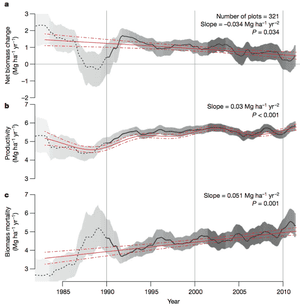The Amazon
Rainforest as a vital carbon sink
The Global
carbon cycle essentially refers to the exchange of carbon between the Earth’s
various carbon reservoirs. There are 5 main reservoirs (The Earth’s interior,
the atmosphere, the biosphere, the oceans and the sediments) which are all
interconnected by pathways of carbon exchange.
Changes in
the carbon cycle can be environmentally devastating. Indeed, perhaps one of the
greatest threats encountered by humans is the ever increasing amount of carbon
released into the atmosphere from the burning of fossil fuels. This additional
carbon reacts with oxygen to form carbon dioxide, a greenhouse gas which has
been responsible for the recent rise in global average temperatures. As the
amount of carbon increases in the atmosphere other carbon sinks become more and
more important in buffering and controlling this increase.
Consequently,
the Amazon rainforest plays a crucial role in the global carbon cycle as it
acts as a carbon sink (which refers to an area’s ability to store and absorb CO2
from the atmosphere). Indeed, as trees grow they absorb much more CO2
(in the order of hundreds of millions of tons) than is released by tree death. Consequently,
the Amazon holds 17 percent[1]
of all Earth’s terrestrial vegetation carbon stock.
However,
human impacts have put the rainforest under an increasing amount of strain both
directly through rapid deforestation and indirectly through changes in climate
patterns caused by warmer global temperatures.
The Amazon has
witnessed an increasing amount of droughts in the past decades which is in part
caused by an increase in El Nino events which leads to dry conditions in the
northern Amazon[2]. Consequently, average rainfall levels dropped
nearly 3.2 percent per year between 1970 and 1998[3]
in the Amazonia region. There have also been extensive dry periods such as the
ones in 2005 and 2010 which lead to basin wide losses in biomass.
The 2010
drought for instance, lead to a higher biomass mortality rate and a lower
biomass productivity rate[4].
There was also an increase in wild fires due to the dry conditions. As a result, it has massively reduced the
Amazon’s ability to act as an efficient carbon sink as the forest essentially
became carbon neutral (meaning that it is absorbing as much carbon as it is releasing).
Unfortunately,
the effects of a drought are not only catastrophic in the short term but they
are also alarming in the long term. Indeed, the effects of a drought such as
the one in 2005 has “persisted for years” with the damage in the forest canopy lasting
“right up to the subsequent drought in 2010”[5].
Consequently, in the future the Amazon won’t be as efficient in storing carbon
than in the past as trees will become increasingly damaged due to the combined
effects of persistent droughts and slow recovery times.
Not only has climate variation impacted the Amazon’s ability
to act as a carbon sink. Extensive deforestation has also been a major culprit.
Indeed, if deforestation continues at this current rate most of the Amazonian
tropical forests would disappear in 50 to 100 years[6].
Currently, the Amazon deforestation is causing up to 10 percent of all
greenhouse gas emissions due to the removal of forests which would have been
able absorbed that CO2 if they were still there. Unfortunately, this
is contributing to our Earth’s rising temperatures.
In conclusion, due to human activity, the Amazon trees have
removed nearly a third less carbon in the past decade than before[7] and have suffered major changes in biomass (figure 1).
Still, the Amazon absorbs more CO2 than it releases making it a
vital carbon sink. However, if current rates of deforestation and droughts
continue at this speed, the Amazon will become permanently carbon neutral which
would disrupt our planet’s entire carbon cycle leading to catastrophic events
such as massive loss of biodiversity and even faster increases in global
temperatures.
Figure 1 the Amazon rainforest's net biomass change, productivity
and, biomass mortality over the past 25 years[8]:
Short BBC clip on the Amazon rainforest which is our planet's lungs:
Sources:
Web sources:
Research papers:
Feldpausch, T. R., et al. (2016), Amazon forest response to repeated droughts, Global Biogeochem. Cycles, 30, 964–982, doi:10.1002/2015GB005133
Shukla,
J., C. Nobre, and P. Sellers. 1990. Amazon deforestation and climate change.
Science 247: 1322-25
Numerous researchers. 2015. Long-term decline of the Amazon
carbon sink. Nature 519: 344-348
[1] Feldpausch, T. R., et al. (2016), Amazon forest response to repeated droughts, Global Biogeochem. Cycles, 30, 964–982, doi:10.1002/2015GB005133
[4] Feldpausch, T.
R., et al. (2016), Amazon forest response to
repeated droughts, Global Biogeochem. Cycles, 30, 964–982, doi:10.1002/2015GB005133
[6] Shukla, J., C. Nobre, and
P. Sellers. 1990. Amazon deforestation and climate change. Science 247: 1322-25
[8] Numerous researchers. 2015. Long-term
decline of the Amazon carbon sink. Nature 519: 344-348

No comments:
Post a Comment